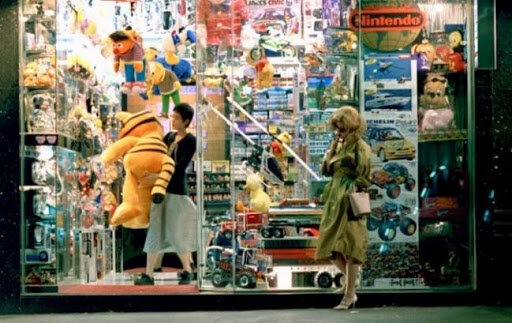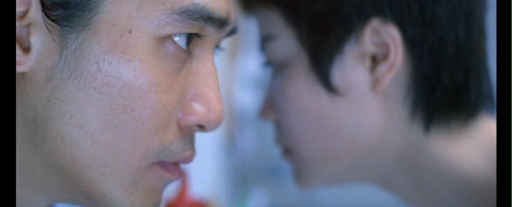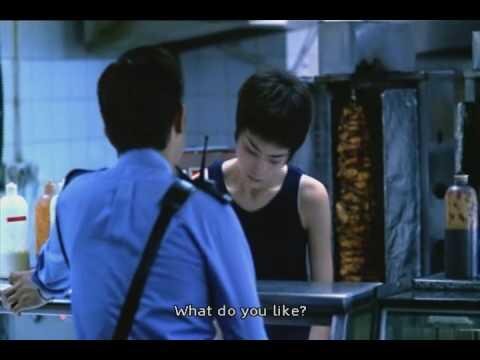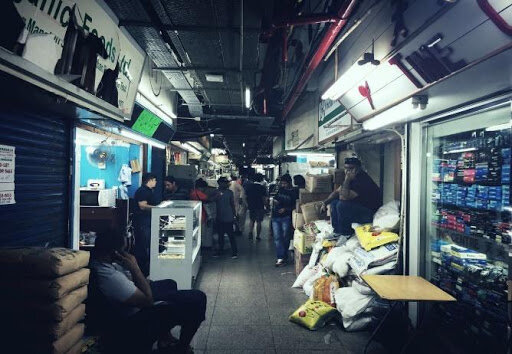
(Image: joannakrutka.com)
California Dreaming in Concrete Forests of Hong Kong in “Chungking Express”
by Ruohao Yan
Introduction
Chungking Express, a 1994 movie about romantic and urban life in Hong Kong, depicts the glamour of the metropolitan life and social issues in Hong Kong. The film director, Wong Kar-Wai, describes two love stories between ordinary citizens. In the first romantic story, a police officer, went by the number “223” broke up with his girlfriend on April fool's day, but he was trying to salvage his relationship with her. A month later, he found that his girlfriend had a new love, so chose to give up and went to a bar to forget. He met a female drug dealer in the bar who was betrayed by her boyfriend. The two spent the night together. However, their relationship did not work out. In the second story, a police officer, went by the number “663”, had been in a depression for a long time due to his breakup with his girlfriend. During this period, a female clerk “Fei” who worked in a fast food restaurant and secretly loved 663 found a key to his home. She often went to 663 home to clean it. One day, 663 found Fei in his home when he returned. However, 663 did not blame her but fell in love with her. He invited her to a bar named California, but on that day, Fei went to the real California in the US. A year later, Fei returned to Hong Kong and visited the fast-food restaurant. She found out that the new owner was 663. The film not only highlights the beauty of Hong Kong, but also touches upon the dark side of society.
Analysis of Hong Kong's Unique Charm and Distorted Society Based on Chungking Express
Since Hong Kong was ruled by the British for 100 years, it not only carries the quintessence of China's 5,000-year culture, but also welcome new ideas, values, and economic systems of modern Western countries (1). Unlike mainland China's socialist system, Hong Kong has followed a century of capitalism, even after its return to the Chinese ruling in 1997. Therefore, Hong Kong has a special cultural system. The film scenes not only show street food stalls with Chinese characteristics, but also convenience stores and fast food restaurants with Western characteristics. In addition, the characters in the movie from diverse parts of the world besides Hong Kong citizens. This not only proves the acceptance of the international culture of Hong Kong society but also shows that people from all over the world have found their culture in Hong Kong. The film uses English, Mandarin, and Cantonese to demonstrate the unique culture of Hong Kong. The cultural philosophy of accepting foreign cultures has made Hong Kong's economy develop rapidly in the past few decades. The film shows the prosperity of the different districts in Hong Kong, such as luxury airports, bustling streets, towering skyscrapers, and the beautiful Victoria port.
Nonetheless, the film also reveals many problems in Hong Kong as a result of the economic prosperity and rapid development. Although Hong Kong follows the development path of new urbanism and has developed rapidly, it has overlooked small urban areas. Hong Kong has a population of seven million and an area of 1104 square kilometer (2). Even if Hong Kong is home to many high-rise buildings designed by famous designers, its per capita housing area is still small. The crowded dorms and apartments in the film are a great example of this in dim light. Hong Kong also has attracted many outsiders due to its rapid development and high economic prosperity. This has made it a highly competitive city, so only higher incomes can match its sky-high property prices. Because of the fast-paced lifestyle, many people are unwilling to invest time in connecting with others. Many citizens become isolated individuals in the society.
A Distance from a Hemisphere in a Fast Food Restaurant
In the fast-paced efficient city of Hong Kong, people's efficiency in work also affects their lives. People in metropolis tend to invest less time in relationships than those in the countryside (3). They are unwilling to spend too much time on trivial life and emotional problems. The shots of fast-food restaurants and convenience stores that appear frequently in movie can prove this. Moreover, every relationship may start soon and end soon. Every relationship like a canned pineapple with a shelf life. The people in the movie are also fickle because they can quickly recover from a failed relationship and start the next one. Many details of the film also hint at the fast pace of urban life. 223's internal monologue at the beginning of the film directly tells the audience that the story line of the first story is only 57 hours. In the first story, the scene of the electronic clock in the fast food restaurant is also constantly reminding the audience of the storyline time, which indicate that the storyline is moving fast. In fast-paced, crowded Hong Kong, human relationships tend to be diluted.
Hong Kong's high population density means that every citizen encounters thousands of people every day. Although the two stories do not overlap, the protagonists of both stories appear in the same place. 223 met Fei in the restaurant (Figure 1), and the female drug dealer also met Fei in the convenience store (Figure 2). Even though they are physically close, they are psychologically far apart. Furthermore, the director used montage editing methods to emphasize the distance of the psychological gap (figure 3). The director used the end of middle and long shot to show 663 ordering food from Fei in the fast food restaurant. From the medium shot, the two men are very close to each other (figure 4). However, when the close shot is cut to the end, the director blurs Fei's face to give the audience the illusion that they are far away from each other (figure 5). 663 and Fei eventually fall in love. Although they are separated in space and time, they are attached to each other. The distance between California and Hong Kong is an irony of the fast-paced emotional life in Hong Kong.

Figure 3: Fei and Female Drug Dealer in the Convenience Store. Cite from: https://www.dailymotion.com/video/x11570w

Figure 3: 223 and Fei in the Fast Food Restaurant (Cite from: https://www.dailymotion.com/video/x11570w)
The director may have rendered existentialism in this film because he spent a lot of time to portray and emphasize each person's life instead of social activities. The frequency of the inner monologue in the movie appears frequently and the frequency of each of the protagonists' individual scenes is also high. This also reflects a problem in Hong Kong where people are isolated. For example, 223 alone run on the playground in the early morning, and Fei went to the 663 home to clean up the room. Sometimes they are more willing to live in their own world. Some social activities of Hong Kong people are sometimes simple and forced.

Figure 4: Medium Shot. Cite from: https://ift.tt/38sAuvG

Figure 5: Close Shot. Cite from: https://www.dailymotion.com/video/x11570w

Figure 3: Montage Editing Methods. Information from: https://www.dailymotion.com/video/x11570w
For example, people must interact with their bosses and colleagues every day and must interact with the landlord every month (4). People enjoy the convenience and diversity brought by modern society but pay a lot of price for these changes. In the reinforced concrete urban jungle, dense and shabby living places, and cramped environment often become the space that blocks and imprisons people's lonely bodies. However, in the seemingly prosperous and noisy urban environment, it is the isolated interpersonal space that refuses to communicate and only loneliness and indifference pass by.
Chungking Mansions and Capitalism
In the first story, a very important scene of the film is the Chungking Mansions in Hong Kong because it may be a microcosm of Hong Kong (Figure 6). “Chungking” refers to the Chunking Mansions while “Express” symbolizes the fast-paced life of Hong Kong. The film was named Chungking Forest when it was released in China and Hong Kong. It means a concrete forest filled with Chungking buildings. The original design of the Chungking building, completed in 1961, was defined as a high-end commercial complex (Figure 7). However, due to the high crime rate in the surrounding environment and the chaotic construction management, the building environment deteriorated in the 1970s (Figure 8). Therefore, Chungking Mansions became a failure case in the history of Hong Kong architecture (5). The capitalist system in the past hundred years made Hong Kong's economy flourish, but it also caused the uneven distribution of social wealth and changed the social and built environment. It built Chungking mansions and changed it. According to the changes in the Chungking Mansions, human activities affect the built environment, and the built environment is also able to mirror social activities, life, and the environment. Both commercial and residential spaces are crowded, dim and, not clean. The public lives and works around the built environment, which changes because of human activities. However, the built environment often has a negative impact on health, life, and society (6). This reminds me of the scene in another movie, ‘The Cabin of Dr. Kracauer’, where the built environment and the natural environment are hostile to ordinary people. The distorted physical environment is like sabers and spears pointing to ordinary humans in the environment, but people have to live in the environment (7). Although the built environment has changed modern people to a greater or lesser extent, individuals choose the degree of environmental transformation according to their values. In my opinion, there is often a lower limit to how the built environment can change people, but the upper limit may depend on how people perceive the environment.

Figure 6: Chungking Mansions Block Plan. Information from: http://dencity-studio.blogspot.com/2013/10/chungking-mansions-organic-dystopia.html

Figure 7: Chungking Mansions Exterior. Cite from: https://travel.qunar.com/p-pl5585771

Figure 8: Chungking Mansions Interior. Cite from: https://www.6parknews.com
Different Values in the Hostile Environment and California Dreaming
The story between the two female characters in the movie shows a great contrast. Throughout the storyline, the female drug dealer probably knows Hong Kong's distorted environment best. Everyone’s perception of the city life will be influenced by their previous impressions or experiences (8). Therefore, she may have visited many chaotic environments like the Chungking Mansions and have seen too many dark issues of the society. The scenes she appears in in the movie are often accompanied by dim lighting and messy environment. She also has far fewer dialogue than the other three, which makes her seem cold and insecure. In her monologue, she stated that she is an extremely insecure person because she was afraid of the hostile environment. She is not willing to follow the rules of simple life but wants to make money quickly through crime. Her feelings with her drug dealer boyfriend are also maintained through money. When her business was betrayed by a drug dealer companion, her boyfriend no longer trusted her and sent many killers to kill her. She quickly becomes aware of the danger, and kills the killers and her boyfriend. Her actions also implied that she was always protecting herself. The squalor of the noisy building and her own desire made her a dark part of the social environment. At the end of the film, blinded by darkness and intrigue, she chooses to escape from the city that disappoints her.
Fei's story is the most romantic part of the film. Compared to the female drug dealer, the film’s lens shows her life trajectory much simpler. She may not have experienced the noisy environment and the dark side of society, which makes her life, behavior, and thought purer. She went to 663 alone to clean his rooms and dreamed of living with her beloved. Even if her life is not rich, she is trying to save money in order to get to the sunny California instead of improving her quality of life. She also believes that life is full of hope and curiosity about the unknown world. Her dreams are not limited by the social environment. Therefore, she often plays the California Dream loudly in the fast food restaurant. Although the built environment confined her to the prison of urban life, she did not succumb herself to this hostile environment. Her vision and values became the motivation for her dreams.
The two love stories of this film are understatement and not vigorous. However, it reflects the subtle relationship between characters and the complex urban history and social reality. The special humanistic feeling created by urban architecture, space, and layout has become the unique narrative language of the film, while the unique physical space organization has all become the product of historical change, social transformation, and the development of the times. The built environment changes the behavior of modern people all the time, but everyone chooses the way to be changed according to his own values.
References
1- Chan, Ming K., and John D. Young., Precarious Balance: Hong Kong Between China and Britain, 1842-1992 (Beijing: Routledge, 2015), 3-9.
2- Ng, Edward, et al. "A study on the cooling effects of greening in a high-density city: An experience from Hong Kong." Building and environment 47 (2012): 256.
3- Simmel, Georg. "The metropolis and mental life." The urban sociology reader (2012): 12.
4- Giles-Corti, Billie, et al. "City planning and population health: a global challenge." The lancet 388, no. 10062 (2016): 2916-2924.
5- Mathews, Gordon. "Chungking Mansions: A Center of" Low-end Globalization." Ethnology 46, no. 2 (2007): 170-1.
6- Perdue, Wendy Collins, et al., "The built environment and its relationship to the public’s health: the legal framework." American journal of public health 93, no. 9 (2003): 1390-1394.
7- Carroll, Noël. "The Cabinet of Dr. Kracauer." Millennium Film Journal 1, (1998): 80.
8- Simmel, Georg. "The metropolis and mental life." The urban sociology reader (2012): 18.
Bibliography
Carroll, Noël. "The Cabinet of Dr. Kracauer." Millennium Film Journal 1, (1998): 77-85.
Chan, Ming K., and John D. Young., Precarious Balance: Hong Kong Between China and Britain, Beijing: Routledge, 2015
Giles-Corti, Billie, et al. "City planning and population health: a global challenge." The lancet 388, no. 10062 (2016): 2912-2924.
Mathews, Gordon. "Chungking Mansions: A Center of" Low-end Globalization." Ethnology 46, no. 2 (2007): 169-183.
Ng, Edward, et al. "A study on the cooling effects of greening in a high-density city: An experience from Hong Kong." Building and environment 47, (2012): 256-271.
Perdue, Wendy Collins, et al., "The built environment and its relationship to the public’s health: the legal framework." American journal of public health 93, no. 9 (2003): 1390-1394.
Simmel, Georg. "The metropolis and mental life." The urban sociology reader, (2012): 11-19.

LOGO DESIGNED BY MEENTS ILLUSTRATED
from REVIEW BLOG - Every Movie Has a Lesson https://ift.tt/2PL0utZ







No comments:
Post a Comment